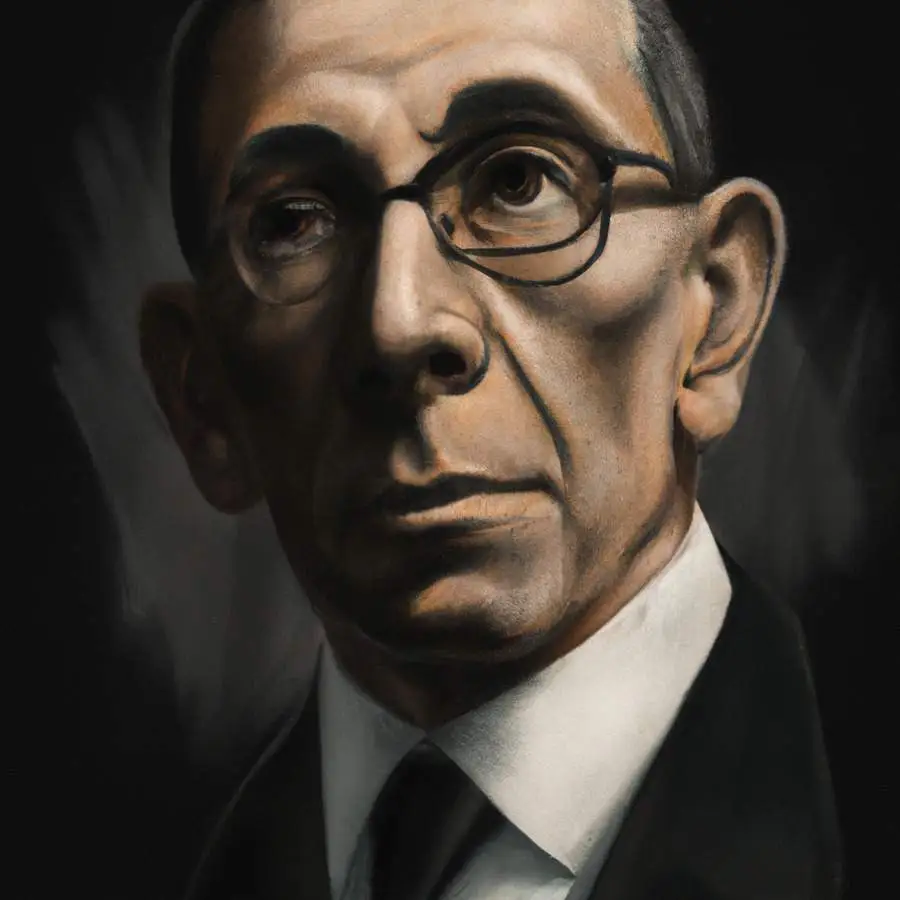Exploring the Life and Legacy of André Gide: A Journey Through Literature and Collaboration
Born on November 22, 1869, in Paris, André Gide ‘s early years were marked by curiosity, creativity, and an innate love for literature. Growing up in a household filled with his father’s extensive library, Gide was exposed to the works of literary giants such as Victor Hugo, Goethe, and Shakespeare from a young age. This early exposure ignited his passion for storytelling and paved the way for his remarkable literary journey.
Gide’s education took place at the Ecole Alsacienne, a renowned school in Paris. It was during these formative years that his literary inclinations truly began to flourish. His academic pursuits were complemented by his growing interest in writing, as he penned poems, essays, and even experimental pieces that showcased his precocious talent.

Literary Career and Exploration:
Gide’s literary career officially commenced in 1891 with the publication of his debut novel, “The Notebooks of André Walter.” This marked the emergence of a distinctive voice that would go on to challenge societal norms, question morality, and delve into the depths of human psychology. With “The Immoralist” in 1902, Gide gained wider recognition for his bold exploration of personal liberation versus societal constraints.
Gide’s body of work is a testament to his intellectual curiosity and creative restlessness. His novel “Strait Is the Gate” (1909) delved into the complexities of religious fervor and its impact on human relationships. His innovative narrative techniques were on display in “The Counterfeiters” (1925), a work that examined authenticity and creativity through a mosaic of interconnected characters.
Exploration of Morality and Ethics:
Throughout his career, Gide was fascinated by questions of morality and ethics. He believed in the importance of individuality and authenticity, often challenging conventional moral values. In his semi-autobiographical work “Strait Is the Gate,” he delved into the complexities of religious and moral fervor, highlighting the conflicts they can create within a person’s psyche.
André Gide: Literary Works and Influences
Gide’s body of work is diverse, ranging from novels and plays to essays and journals. His writing style evolved over the years, reflecting his ongoing intellectual exploration. Works like “Fruits of the Earth” celebrated the beauty of nature, while “The Counterfeiters” experimented with narrative techniques and explored the nature of creativity.
Collaboration with Other Writers:
André Gide’s literary journey was not a solitary one; he engaged in meaningful collaborations and exchanges with other writers and thinkers of his time. One notable figure was the Irish playwright and writer Oscar Wilde. Their correspondence not only revealed mutual admiration but also provided insights into their thoughts on art, individualism, and societal conventions.
Gide’s collaboration extended to his interactions with Marcel Proust, a prominent French novelist. Their letters exchanged ideas, reflections, and critiques of each other’s work. These exchanges showcased a depth of intellectual engagement that contributed to the enrichment of their respective creative endeavors.

Travels and Encounters:
Gide’s travels played a crucial role in shaping his worldview. His journeys to North Africa and the Congo influenced his perception of colonialism and imperialism. These experiences ignited his interest in social justice and human rights, leading him to voice his concerns through his literary works.
Nobel Prize and Legacy:
In 1947, André Gide was awarded the Nobel Prize in Literature for his “courageous and uncompromising” work. His legacy extends beyond his literary achievements. Gide’s intellectual openness and willingness to challenge societal norms paved the way for later generations of writers and thinkers to explore complex themes fearlessly.
Legacy and Continuing Influence:
André Gide’s legacy endures through his exploration of moral dilemmas, societal norms, and the intricate nuances of human nature. His courage in challenging established conventions opened doors for later generations of writers to navigate uncharted literary territories. His legacy resonates in the works of modern writers who continue to tackle complex themes and push the boundaries of creative expression.
As we reflect on André Gide’s life, from his early years of exploration to his collaboration with fellow writers, we uncover a man whose words continue to inspire, provoke, and encourage readers and thinkers to embark on their own intellectual journeys. His legacy reminds us of the power of literature to illuminate the human experience and challenge the status quo.
Personal Exploration and Identity:
Gide’s personal life was as complex as his literary works. He entered into a marriage with his cousin, Madeleine Rondeaux, and even fathered a daughter named Catherine. However, his struggles with his own identity, including his eventual revelation of his homosexuality, added layers of complexity to his experiences.
These personal struggles found expression in his writings, as he examined themes of identity, authenticity, and the clash between societal expectations and individual desires. His autobiographical work “If It Die…” (1926) offered a candid look into his personal journey, revealing the challenges he faced in reconciling his public and private personas.
Personal Struggles and Identity:
Gide’s personal life was marked by struggles with his own identity, including his sexuality. He married, had a family, and later revealed his homosexuality. These experiences shaped his writings, particularly his exploration of the conflicts between societal expectations and personal authenticity.
Chronological list of some works of André Gide:
- The Notebooks of André Walter (Les Cahiers d’André Walter) – 1891
- Marshlands (Paludes) – 1896
- The Fruits of the Earth (Les Nourritures terrestres) – 1897
- Strait Is the Gate (La Porte étroite) – 1909
- The Immoralist (L’Immoraliste) – 1902
- If It Die… (Si le grain ne meurt) – 1926 (Autobiography)
- The Vatican Cellars (Les Caves du Vatican) – 1914
- The Counterfeiters (Les Faux-monnayeurs) – 1925
- Corydon – 1924 (Essay on homosexuality)
- Travels in the Congo (Voyage au Congo) – 1927
- The Pastoral Symphony (La Symphonie Pastorale) – 1919
- The School for Wives (L’École des femmes) – 1936 (Play adaptation)
Please note that this list includes some of his most notable works and is not exhaustive. Gide’s literary output was diverse and extensive, spanning various genres and themes throughout his career.
Trivia facts about André Gide:
- Early Literary Experimentation: As a young writer, Gide began his literary journey by penning poems, plays, and stories in a secret language he created with a friend. This early experimentation with language and form foreshadowed his later innovative approach to literature.
- Symbolic Turtle: Gide had a unique fascination with turtles, which he saw as symbols of wisdom and patience. He often used the image of a turtle in his personal seal and even named his publishing house “Les Éditions de la Tortue” (The Turtle Editions).
- Conflict with the Catholic Church: Gide’s exploration of morality and sexuality in his works, particularly in “Corydon,” led to conflicts with the Catholic Church. His ideas and open discussions about homosexuality were met with criticism from religious authorities.
- Friendship with Oscar Wilde: Gide had a correspondence with the renowned Irish playwright and writer Oscar Wilde. Gide was inspired by Wilde’s wit and individualism, and their exchanges influenced his own views on art and society.
- Pseudonyms and Anagrams: Throughout his writings, Gide used various pseudonyms and anagrams to sign his works, adding an element of mystery and playful complexity. One of his most famous anagrams was “Egidius,” which he used for some of his works.
- Personal Nobel Prize Decline: In 1923, Gide was awarded the Nobel Prize in Literature for his book “The Counterfeiters.” However, he declined the honor, stating that he did not want to be pigeonholed by literary distinctions and preferred to maintain his independence.
- Literary Exchange with Marcel Proust: Gide and Marcel Proust, another prominent French writer of the time, exchanged letters discussing literature, art, and life. Their correspondence offers insights into their creative processes and intellectual engagement.
These trivia facts showcase the multi-faceted personality and unique contributions of André Gide to literature and thought.
Conclusion: André Gide
André Gide’s life journey was one of intellectual curiosity, creative exploration, and a commitment to challenging the status quo. Through his literary contributions, he expanded the horizons of French literature and philosophy, leaving a lasting impact on the world. His legacy encourages us to embrace individuality, question norms, and embark on a journey of self-discovery.
Reviews of works of André Gide
Corydon (by Andre Gide)
“Corydon” by André Gide: A Provocative Exploration of Desire, Identity, and the Boundaries of Love…
Strait is the Gate
“Strait is the Gate” by André Gide: A Profound Exploration of Love and the Human…
The Counterfeiters
Complexities: Exploring “The Counterfeiters” by André Gide My Thoughts on The Counterfeiters by André GideI…
The Immoralist
A Journey of Self-Discovery and Moral Dilemmas: ‘The Immoralist’ by Andre Gide “The Immoralist,” penned…



